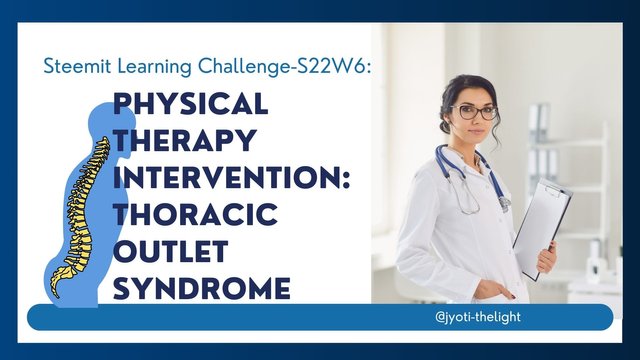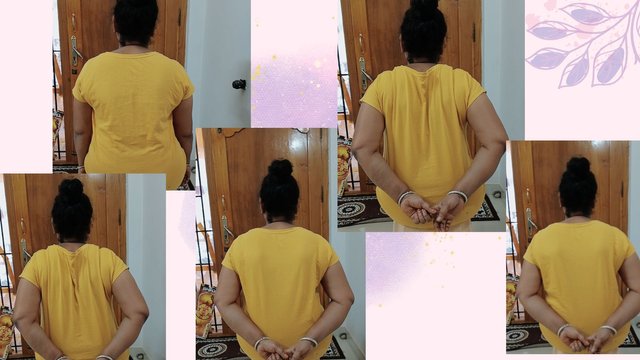Steemit Learning Challenge-S22W6; Thoracic Outlet Syndrome
Hi friends,
I am Jyoti from India. Here I am going to participate in the SLC S22 W65 contest: https://steemit.com/hive-127432/@ashkhan/steemit-learning-challenge-s22w6-physical-therapy-intervention-thoracic-outlet-syndrome organised by @ashkhan

What's a thoracic outlet syndrome? Write in your own words after getting knowledge from the lesson post.
Thoracic Outlet Syndrome happens when body elements compress nerves and blood vessels in the thoracic outlet area.
Thoracic Outlet Syndrome occurs when nerves and blood vessels get squeezed in the space at the top of your ribs. Turns out the neck area between ribs holds important body structures like the brachial plexus and subclavian blood pathways.
Medical professionals sometimes label this medical situation as Cervical Rib disorders or Costoclavicular Syndrome. These naming systems indicate specific differences in your body's structure and the places where compression happens. Extra ribs in particular can damage your body systems.
What Causes TOS?
What triggers this medical condition? There are several common culprits:
Occupational Activities:When your work involves overheard lifting motions with heavy objects you need to guard against this condition. People who work as painters or construction workers extend their arms frequently while standing.
Poor Posture:Your sleeping position affects your risk for this issue. Positioning your arms straight above you during sleep creates strain which results in symptoms.
Acute Trauma:Damage from car accidents particularly whiplash makes TOS symptoms more likely because it forces your neck into extreme flexion and extension movements.
Sports Activities:When performing swimming volleyball or baseball use you boost your odds of getting TOS because these sports make you do many arm movements.
Previous Injuries:Past harms may return when you don't handle your situation correctly.
Recognizing Symptoms
As your initial step in evaluating TOS symptoms is important to learn about them. They typically fall into two categories: You will experience differences between vascular problems with blood flow and neuropathic problems with nerves.
Vascular Symptoms:
- Bluish Tint in Hands: Blood vessel problems create these signs during activities requiring you to keep your arms above your head.
- Coldness & Heaviness: When working out, you will find your arms feel uncomfortable because blood flow to them becomes limited.
- Throbbing Pain: You might notice a steady pain pulsing in your chest, neck arms or hands.
- Swelling: Extra fluid builds up under your skin, making you look puffy around your armpit area and moving up to your arm and above the collarbone on your chest plus your hands.
- Fatigue & Weakness: Fatigue and weakness spread throughout your hands and arms and become easy to notice.

How would you diagnose a thoracic outlet syndrome? Any clinical investigation or assessment tests?
Understanding Thoracic Outlet Syndrome (TOS) Diagnosis:
If you’ve ever experienced shoulder pain, numbness in your fingers, or even a tingling sensation that seems to radiate from your neck down your arm, you might be dealing with a condition known as Thoracic Outlet Syndrome (TOS). While it can sound daunting, understanding how TOS is diagnosed can empower you to take the next steps towards relief and recovery. Let’s dive into the various methods used for diagnosing this condition and what they entail.
The Importance of History Taking
Diagnosis begins with a detailed history taking. Your healthcare provider will ask questions about your family history, occupational exposures, past medical conditions, and any previous surgeries. This background information is crucial since TOS can often be linked to repetitive activities or specific postures that you might encounter at work or during daily life.
For instance, if you work long hours at a computer or participate in activities like swimming or playing musical instruments, these factors could be contributing to your symptoms. Gathering this information helps your physician understand potential risk factors and tailor their approach.
Physical Examination:
Once the history is established, a thorough physical examination follows. This step may involve both a physician and a physical therapist assessing your posture, range of motion, and any areas of tenderness. They'll also evaluate how well your muscles are functioning and whether there are any noticeable signs of nerve compression.
During this examination, expect some hands-on assessments designed to reproduce your symptoms. The clinician may observe how certain positions affect your pain or discomfort levels.
Imaging Techniques:
Medical scans help doctors confirm TOS diagnosis. Your doctor uses X-rays to look for any bone changes around the thoracic outlet region and whether you have arthritis. The ultrasound scan creates detailed images that show muscle and tendon problems at their soft tissue level. An MRI scan creates clear pictures of the thoracic outlet area to show possible problems with nerves and blood vessels.
Assessing Nerve Function: EMG & NCS
To see how nerves work doctors conduct Electromyography (EMG) and Nerve Conduction Studies (NCS). These tests evaluate how nerves and muscles talk to each other plus spot nerve damage as the root of your discomfort. This data assists in identifying TOS severity to choose proper treatment paths.

###Try to practice at least 3 exercises that you have learned from the lesson. Share images, gifs or videos while practicing preferably gifs or videos.
The Technique: How I Do Shoulder Shrugs

To do this exercise, we need to sit on a flat stool. Our shoulders and back should be straight and our head should be upright. I sat on a stool and folded my arms behind me. Then I stretched my shoulders towards my back so that both shoulders were in the middle. Then I came to the normal position and stretched again so that both shoulders were in the middle. I did this several times.
The Best Exercises for Shoulder Retraction
.jpg)
To do this exercise, you need to sit on a flat stool. Your back and neck should be straight. Your hands should be placed on your thighs. I sat on the stool and placed my hands on my thighs. Then I sketched my two shoulders to touch my ears. After that, I brought them to the normal position. Then again, in the same way, I lifted and touched my two shoulders to touch my ears. Then I brought them to the normal position. I repeated the same test.
Getting Started with Straight Arm Shoulder Extension

To do this exercise, you need to take a stick or pipe. I took my son's cricket stem and then stood straight on the ground. Then the thing to note is that our heels and toes should be well planted on the ground and we should stand upright. Our hands should be backwards. We should hold this stick in it. I held it and stood like that and then slowly raised my hands along with the stem and lifted it up towards the back and stretched it as much as I could. Then I slowly brought it to the normal position and did this practice many times.

Share your review after performing these exercises either on yourself, a healthy individual or a patient.
Improving scapula retraction has been an enlightening journey filled with muscle discoveries and newfound strength! From understanding the importance of my scalene muscles to embracing exercises that target my rhomboids, I’ve learned how critical this aspect is for overall posture and upper body health.
If you’re struggling with slouched shoulders or simply want to improve upper body strength, I encourage you to start focusing on scapular retraction. Trust me; it will make all the difference!
I spend a lot of time on the computer, which causes pain in my back, and I also get occasional pain in my shoulders because I work with my hands. When I did these exercises, my shoulder and upper back felt like they were free, and the pain was reduced.
So there you have it—a simple yet effective exercise that has made such a difference in my life while managing thoracic outlet syndrome. Remember, always listen to your body and consult with a healthcare professional if you're unsure about starting new exercises.

I would like to invite my friends
@dasudi ,
To take part this contest
Discord : @jyoti-thelight#6650 Telegram :- https://telegram.org/dl

Congratulations, your post has been upvoted by @scilwa, which is a curating account for @R2cornell's Discord Community. We can also be found on our hive community & peakd as well as on my Discord Server
Felicitaciones, su publication ha sido votado por @scilwa. También puedo ser encontrado en nuestra comunidad de colmena y Peakd así como en mi servidor de discordia
You performed exercises well
But you switch between images of shoulder shrugs with shoulder retraction.....
Please correct it......
Thank you for understanding the lesson and sharing your assignment; I hope that you will enjoy this week's lesson and try to implement it in your life if you see any such case.
Observations
Task 1 (2.7/3)
You have shared a great knowledge about thoracic outlet syndrome, its vascular symptoms, causes, types and other names. But didn't add neurogenic symptoms of TOS. A bit more depth require to complete the answer. I appreciate your effort.
Task 2 (2.6/3)
In the second question, you tell us about how you have to assess a patient by doing physical examination, history taking, and investigations. It would be better to add special tests and also explanation of special tests. Good.
Task 3 (3.8/4)
You try the shoulder shrugs, retraction and straight arm extension. You did the shoulder shrugs, retraction and extension correctly. But you mix the images or name of exercises of shoulder shrugs and retraction. Next time carefully check before publishing. Always remember to apply heat pack in chronic condition and ice pack in acute condition before performing exercises to relax the muscles and reduce stiffness. I appreciate your efforts.
Overall you made a great attempt to answer all the questions. I appreciate your efforts. Keep learning and try to implement your knowledge to the people suffering from thoracic outlet syndrome or any type of spine issue. Thank you.
Thank you for the evaluation.